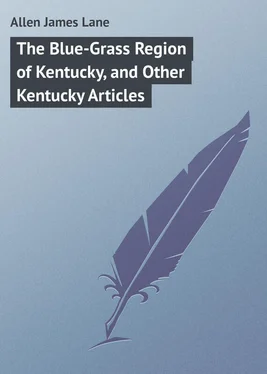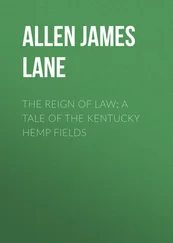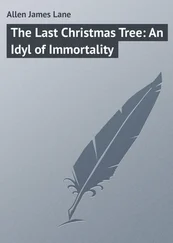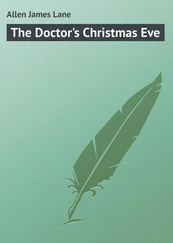James Allen - The Blue-Grass Region of Kentucky, and Other Kentucky Articles
Здесь есть возможность читать онлайн «James Allen - The Blue-Grass Region of Kentucky, and Other Kentucky Articles» — ознакомительный отрывок электронной книги совершенно бесплатно, а после прочтения отрывка купить полную версию. В некоторых случаях можно слушать аудио, скачать через торрент в формате fb2 и присутствует краткое содержание. Жанр: foreign_prose, Путешествия и география, на английском языке. Описание произведения, (предисловие) а так же отзывы посетителей доступны на портале библиотеки ЛибКат.
- Название:The Blue-Grass Region of Kentucky, and Other Kentucky Articles
- Автор:
- Жанр:
- Год:неизвестен
- ISBN:нет данных
- Рейтинг книги:3 / 5. Голосов: 1
-
Избранное:Добавить в избранное
- Отзывы:
-
Ваша оценка:
- 60
- 1
- 2
- 3
- 4
- 5
The Blue-Grass Region of Kentucky, and Other Kentucky Articles: краткое содержание, описание и аннотация
Предлагаем к чтению аннотацию, описание, краткое содержание или предисловие (зависит от того, что написал сам автор книги «The Blue-Grass Region of Kentucky, and Other Kentucky Articles»). Если вы не нашли необходимую информацию о книге — напишите в комментариях, мы постараемся отыскать её.
The Blue-Grass Region of Kentucky, and Other Kentucky Articles — читать онлайн ознакомительный отрывок
Ниже представлен текст книги, разбитый по страницам. Система сохранения места последней прочитанной страницы, позволяет с удобством читать онлайн бесплатно книгу «The Blue-Grass Region of Kentucky, and Other Kentucky Articles», без необходимости каждый раз заново искать на чём Вы остановились. Поставьте закладку, и сможете в любой момент перейти на страницу, на которой закончили чтение.
Интервал:
Закладка:
But the ideal landscape of daily life must not be merely beautiful: it should be useful. With what may not the fertility of this region be compared? With the valleys of the Schuylkill, the Shenandoah, and the Genesee; with the richest lands of Lombardy and Belgium; with the most fertile districts of England. The evidences of this fertility are everywhere. Nature, even in those places where she has been forced for nearly a hundred years to bear much at the hands of a not always judicious agriculture, unceasingly struggles to cover herself with bushes of all sorts and nameless annual weeds and grasses. Even the blue-grass contends in vain for complete possession of its freehold. One is forced to note, even though without sentiment, the rich pageant of transitory wild bloom that will force a passage for itself over the landscape: firmaments of golden dandelions in the lawns; vast beds of violets, gray and blue, in dim glades; patches of flaunting sunflowers along the road-sides; purple thistles; and, of deeper purple still and far denser growth, beautiful ironweed in the woods; with many clumps of alder bloom, and fast-extending patches of perennial blackberry, and groups of delicate May-apples, and whole fields of dog-fennel and golden-rod. And why mention indomitable dock and gigantic poke, burrs and plenteous nightshade, and mullein and plantain, with dusty gray-green ragweed and thrifty fox-tail? – an innumerable company.
Maize, pumpkins, and beans grow together in a field – a triple crop. Nature perfects them all, yet must do more. Scarce have the ploughs left the furrows before there springs up a varied wild growth, and a fourth crop, morning-glories, festoon the tall tassels of the Indian corn ere the knife can be laid against the stalk. Harvest fields usually have their stubble well hidden by a rich, deep aftermath. Garden patches, for all that hoe and rake can do, commonly look at last like spots given over to weeds and grasses. Sidewalks quickly lose their borders. Pavements would soon disappear from sight; the winding of a distant stream through the fields can be readily followed by the line of vegetation that rushes there to fight for life, from the minutest creeping vines to forest trees. Every neglected fence corner becomes an area for a fresh colony. Leave one of these sweet, humanized woodland pastures alone for a short period of years, it runs wild with a dense young natural forest; vines shoot up to the tops of the tallest trees, and then tumble over in green sprays on the heads of others.
A kind, true, patient, self-helpful soil if ever there was one! Some of these lands after being cultivated, not always scientifically, but always without artificial fertilizers, for more than three-quarters of a century, are now, if properly treated, equal in productiveness to the best farming lands of England. The farmer from one of these old fields will take two different crops in a season. He gets two cuttings of clover from a meadow, and has rich grazing left. A few counties have at a time produced three-fourths of the entire hemp product of the United States. The State itself has at different times stood first in wheat and hemp and Indian corn and wool and tobacco and flax, although half its territory is covered with virgin forests. When lands under improper treatment have become impoverished, their productiveness has been restored, not by artificial fertilizers, but by simple rotation of crops, with nature's help. The soil rests on decomposable limestone, which annually gives up to it in solution all the essential mineral plant food that judicious agriculture needs.
Soil and air and climate – the entire aggregate of influences happily co-operative – make the finest grazing. The Kentucky horse has carried the reputation of the country into regions where even the people could never have made it known. Your expert in the breeding of thoroughbreds will tell you that the muscular fibre of the blue-grass animal is to that of the Pennsylvania-bred horses as silk to cotton, and the texture of his bone, compared with the latter's, as ivory beside pumice-stone. If taken to the Eastern States, in twelve generations he is no longer the same breed of horse. His blood fertilizes American stock the continent over. Jersey cattle brought here increase in size. Sires come to Kentucky to make themselves and their offspring famous.
The people themselves are a fecund race. Out of this State have gone more to enrich the citizenship of the nation than all the other States together have been able to send into it. So at least your loyal-hearted Kentuckian looks at the rather delicate subject of inter-State migration. By actual measurement the Kentucky volunteers during the Civil War were found to surpass all others (except Tennesseeans) in height and weight, whether coming from the United States or various countries of Europe. But for the great-headed Scandinavians, they would have been first, also, in circumference around the forehead and occiput. Still, Kentucky has little or no literature.
One element that should be conspicuous in fertile countries does not strike the observer here – much beautiful water; no other State has a frontage of navigable rivers equal to that of Kentucky. But there are few limpid, lovely, smaller streams. Wonderful springs there are, and vast stores of water in the cavernous earth below; but the landscape lacks the charm of this element – clear, rushing, musical, abundant. The watercourses, ever winding and graceful, are apt to be either swollen and turbid or insignificant; of late years the beds seem less full also – a change consequent, perhaps, upon the denudation of forest lands. In a dry season the historic Elkhorn seems little more than a ganglion of precarious pools.
The best artists who have painted cultivated ground have always been very careful to limit the area of the crops. Undoubtedly the substitution of a more scientific agriculture for the loose and easy ways of primitive husbandry has changed the key-note of rural existence from a tender Virgilian sentiment to a coarser strain, and as life becomes more unsophisticated it grows less picturesque. When the work of the old-time reaper is done by a fat man with a flaming face, sitting on a cast-iron machine, and smoking a cob pipe, the artist will leave the fields. Figures have a terrible power to destroy sentiment in pure landscape; so have houses. When one leaves nature, pure and simple, in the blue-grass country, he must accordingly pick his way circumspectly or go amiss in his search for the beautiful. If his taste lead him to desire in landscapes the finest evidences of human labor, the high artificial finish of a minutely careful civilization, he will here find great disappointment. On the other hand, if he delight in those exquisite rural spots of the Old World with picturesque bits of homestead architecture and the perfection of horticultural and unobtrusive botanical details, he will be no less aggrieved. What he sees here is neither the most scientific farming, simply economic and utilitarian – raw and rude – nor that cultivated desire for the elements in nature to be so moulded by the hand of man that they will fuse harmoniously and inextricably with his habitations and his work.
The whole face of the country is taken up by a succession of farms. Each of these, except the very small ones, presents to the eye the variation of meadow, field, and woodland pasture, together with the homestead and the surrounding grounds of orchard, garden, and lawn. The entire landscape is thus caught in a vast net-work of fences. The Kentuckian retains his English ancestors' love of enclosures; but the uncertain tenure of estates beyond a single generation does not encourage him to make them the most durable. One does, indeed, notice here and there throughout the country stone-walls of blue limestone, that give an aspect of substantial repose and comfortable firmness to the scenery. But the farmer dreads their costliness, even though his own hill-sides furnish him an abundant quarry. He knows that unless the foundations are laid like those of a house, the thawing earth will unsettle them, that water, freezing as it trickles through the crevices, will force the stones out of their places, and that breaches will be made in them by boys on a hunt whenever and wherever it shall be necessary to get at a lurking or sorely pressed hare. It is ludicrously true that the most terrible destroyer of stone-walls in this country is the small boy hunting a hare, with an appetite for game that knows no geological impediment. Therefore one hears of fewer limestone fences of late years, some being torn down and superseded by plank fences or post-and-rail fences, or by the newer barbed-wire fence – an economic device that will probably become as popular in regions where stone and timber were never to be had as in others, like this, where timber has been ignorantly, wantonly sacrificed. It is a pleasure to know that one of the most expensive, and certainly the most hideous, fences ever in vogue here is falling into disuse. I mean the worm-fence – called worm because it wriggled over the landscape like a long brown caterpillar, the stakes being the bristles along its back, and because it now and then ate up a noble walnut-tree close by, or a kingly oak, or frightened, trembling ash – a worm that decided the destiny of forests. A pleasure it is, too, to come occasionally upon an Osage orange hedge-row, which is a green eternal fence. But you will not find many of these. It is generally too much to ask of an American, even though he be a Kentuckian, to wait for a hedge to grow and make him a fence. When he takes a notion to have a fence, he wants it put up before Saturday night.
Читать дальшеИнтервал:
Закладка:
Похожие книги на «The Blue-Grass Region of Kentucky, and Other Kentucky Articles»
Представляем Вашему вниманию похожие книги на «The Blue-Grass Region of Kentucky, and Other Kentucky Articles» списком для выбора. Мы отобрали схожую по названию и смыслу литературу в надежде предоставить читателям больше вариантов отыскать новые, интересные, ещё непрочитанные произведения.
Обсуждение, отзывы о книге «The Blue-Grass Region of Kentucky, and Other Kentucky Articles» и просто собственные мнения читателей. Оставьте ваши комментарии, напишите, что Вы думаете о произведении, его смысле или главных героях. Укажите что конкретно понравилось, а что нет, и почему Вы так считаете.











